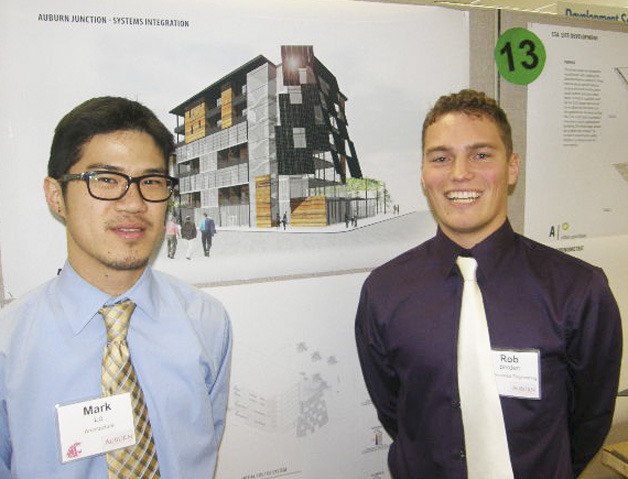Water resource engineering students Eric Palmer and Dave Johnson said “nuts” to dumping stormwater from downtown Auburn into the Green River, opting to treat it in a built wetland instead.
Architectural student Betsy Humbert focused her design eye on stormwater and the Interurban Trail.
Like peanut butter and chocolate, these ideas stood up on their own, but something great happened when the fourth-year architecture student integrated her design with Palmer and Johnson’s water resource work.
And that is the whole point of Integrated Design Experience, or IDEX, Washington State University’s design studio — to combine the genius of budding architects, construction managers and agricultural students with the prowess of environmental, water resources, structural and geotechnical engineers.
WSU contracted with the City of Auburn last year to study stormwater management for most of the community, but in particular in the downtown, connecting it with the environmental park now taking shape between West Main Street and 15th Street Northwest.
Recently, 28 IDEX students presented 20 different design strategies at Auburn City Hall. The City, if it chooses, can use any of them to reduce the demand on its stormwater infrastructure.
Tyler Pierce, a graduate in geotechnical engineering, and Ashraf Alam, a Ph.D structural engineering student, provided alternatives to enhance the boardwalk slated for construction this summer at the environmental park.
“We were trying to build a boardwalk with minimal materials and minimal impact on the wetlands,” Pierce said. “Ashraf was able to go through here and design the system using the smallest materials and working on some different foundation orientations.”
Other students dealt with surfaces, pavements, sidewalks and the final destination of downtown stormwater runoff. Agricultural students studied introducing food production to Auburn, not only producing food but working out how to deal with the biomass at the other end of it.
Mark Lo and Rob Borden worked on designs to help downtown businesses store rainwater, reducing their dependence on the water supply and saving them money.
New approach
Todd Bayreuther, WSU Assistant Professor of Architecture, put it all together.
“These strategies are called decentralized infrastructure, so instead of installing bigger pipes and dealing with bigger treatments of facilities or pumps, they’re trying to either collect water on site, or infiltrate it into the ground using various strategies involving constructed wetlands that deal with water. But you also see a lot of building strategies that relate to humans.
“It’s not just about the systems,” Bayreuther continued, “it’s also about how they are integrated into the urban environment. Normally, civil engineers would only look at the system, and architects would only look at the human element. By combining these things together, you also deal with the ecology, with the birds and other wildlife. We also have to be realistic and deal with the economy and tax revenues and how to pay for these things. It’s a very holistic view.”
Dennis Dowdy, public works director for the City of Auburn, said the projects give the City “perspectives on different ways to take advantage of the natural environment.”
“One of the theses of the effort is how can we take advantage of those in an urban environment, how can we take advantage of the wetlands, which are plentiful in this urban environment,” Dowdy said.
“It’s saying that state-of-the-art stormwater management can improve the stormwater quality and management of the quantity that’s going to come from the downtown and areas around that,” said Auburn City Councilman Rich Wagner. “There are a lot of new federal requirements, and we have to meet those in an economic way. We’re getting a lot of new ideas from these young people about how that could happen. So the main event is to do the right thing for stormwater management.”



